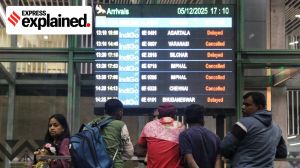Konkan Railway to merge with Indian Railways: Why now, what this will mean
The scenic route from Roha in Maharashtra all the way to coastal Kerala is a lifeline for the movement of passengers and goods across the Konkan coast
 The scenic Konkan route has 91 tunnels and over 2,000 bridges. (Wikimedia Commons)
The scenic Konkan route has 91 tunnels and over 2,000 bridges. (Wikimedia Commons)The Maharashtra government last month officially agreed to merge the Konkan Railway Corporation Limited (KRCL) with Indian Railways.
With Goa, Karnataka and Kerala having already approved the merger, Maharashtra’s decision clears the way for the complete integration of one of India’s most scenic and strategically vital railway lines into the larger national network.
What is the Konkan Railway? How did it come into existence?
The Konkan Railway (KR) was established in 1990 as a special purpose vehicle in the Ministry of Railways to carry out the difficult task of constructing railway lines through the rocky Western Ghats.
The project, which officially began operations in January 1998, sought to connect Roha in Maharashtra, Goa, Mangaluru in Karnataka and coastal Kerala, and become a lifeline for both goods and passenger movement across the Konkan coast.
With a length of 741 km, this scenic but commercially valuable rail route substantially reduced travel time, and connected distant areas to the major towns and cities of the shareholder states.
The KRCL was formed as a joint venture in which the Government of India held a 51% stake, Maharashtra 22%, Karnataka 15%, and Goa and Kerala 6% each. The line was commissioned and completed in the early 1990s and has been a major route ever since, with KRCL always existing as a distinct entity from the Indian Railways.
Why is the merger taking place now?
While being operationally successful, KRCL has been suffering from financial woes for years. With lesser revenues and increasing infrastructure demands, the company found it difficult to finance expansion or afford major upgrades.
The approval of the Maharashtra government was conveyed by Chief Minister Devendra Fadnavis through a letter addressed to Railway Minister Ashwini Vaishnaw. This letter notably states that the “standalone model” itself has become unsustainable, and joining hands with Indian Railways would enable KRCL to leverage the route’s huge investment base.
The merger thus can be a precursor to new projects along the route, improving connectivity, the frequency and quality of services, and ultimately benefiting local economies, tourism and employment in Maharashtra and beyond.
Maharashtra’s hold up thus far was due to the significant investment it had made for the establishment of the KRCL in 1990, and concerns about the Konkan route losing its importance if KRCL were to be merged with the Indian Railways.
Fadnavis’s letter says that any merger is subject to two conditions: one, that the name “Konkan Railway” continues to be used even after the merger; and two, that Indian Railways reimburses Maharashtra with a sum of more than Rs 394 crore for the state’s initial investment. The Centre has reportedly agreed to meet both these conditions.
How will passengers be affected?
The ball now rests in the court of the Railway Board. With all parties approving a merger, the Board will eventually get the process underway, which could entail a number of administrative, financial, and legal steps before the merger is actually completed.
According to sources, the process is likely to involve reworking employee hierarchies, operational areas and service contracts, and could take some months to come to reality.
Once that happens, however, the passengers are likely to benefit from upgraded infrastructure, improved frequency of trains, better security measures, and increased connectivity with other routes of Indian Railways.
A merger could also translate into more competitive fares, seamless booking on Indian Railways channels, and standardised customer grievance redressal mechanisms, something that has long been a challenge for KR passengers.
- 01
- 02
- 03
- 04
- 05






































